Asus P550L, P450L, K552M, K550L, K550J User Manual
...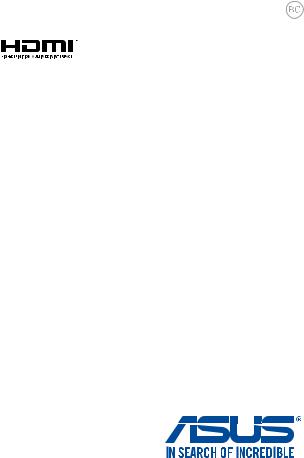
E10594
Revised Edition V4
August 2015
Notebook PC
E-Manual

COPYRIGHT INFORMATION
No part of this manual, including the products and software described in it, may be reproduced, transmitted, transcribed, stored in a retrieval system, or translated into any language in any form or by any means, except documentation kept by the purchaser for backup purposes, without the express written permission of ASUSTeK COMPUTER INC. (“ASUS”).
ASUS PROVIDES THIS MANUAL “AS IS”WITHOUT WARRANTY OF ANY KIND, EITHER EXPRESS OR IMPLIED, INCLUDING BUT NOT LIMITED TO THE IMPLIED WARRANTIES OR CONDITIONS OF MERCHANTABILITY OR FITNESS FOR A PARTICULAR PURPOSE. IN NO EVENT SHALL ASUS, ITS DIRECTORS, OFFICERS, EMPLOYEES OR AGENTS BE LIABLE FOR ANY INDIRECT, SPECIAL, INCIDENTAL, OR CONSEQUENTIAL DAMAGES (INCLUDING DAMAGES FOR LOSS OF PROFITS, LOSS OF BUSINESS, LOSS OF USE OR DATA, INTERRUPTION OF BUSINESS AND THE LIKE), EVEN IF ASUS HAS BEEN ADVISED OF THE POSSIBILITY OF SUCH DAMAGES ARISING FROM ANY DEFECT OR ERROR IN THIS MANUAL OR PRODUCT.
Products and corporate names appearing in this manual may or may not be registered trademarks or copyrights of their respective companies, and are used only for identification or explanation and to the owners’ benefit, without intent to infringe.
SPECIFICATIONS AND INFORMATION CONTAINED IN THIS MANUAL ARE FURNISHED FOR INFORMATIONAL USE ONLY, AND ARE SUBJECT TO CHANGE AT ANY TIME WITHOUT NOTICE, AND SHOULD NOT BE CONSTRUED AS A COMMITMENT BY ASUS. ASUS ASSUMES NO RESPONSIBILITY OR LIABILITY FOR ANY ERRORS OR INACCURACIES THAT MAY APPEAR IN THIS MANUAL, INCLUDING THE PRODUCTS AND SOFTWARE DESCRIBED IN IT.
Copyright © 2015 ASUSTeK COMPUTER INC. All Rights Reserved.
LIMITATION OF LIABILITY
Circumstances may arise where because of a default on ASUS’ part or other liability, you are entitled to recover damages from ASUS. In each such instance, regardless of the basis on which you are entitled to claim damages from ASUS, ASUS is liable for no more than damages for bodily injury (including death) and damage to real property and tangible personal property; or any other actual and direct damages resulted from omission or failure of performing legal duties under this Warranty Statement, up to the listed contract price of each product.
ASUS will only be responsible for or indemnify you for loss, damages or claims based in contract, tort or infringement under this Warranty Statement.
This limit also applies to ASUS’ suppliers and its reseller. It is the maximum for which ASUS, its suppliers, and your reseller are collectively responsible.
UNDER NO CIRCUMSTANCES IS ASUS LIABLE FOR ANY OF THE FOLLOWING: (1) THIRD-PARTY CLAIMS AGAINST YOU FOR DAMAGES; (2) LOSS OF, OR DAMAGE TO, YOUR RECORDS OR DATA; OR (3) SPECIAL, INCIDENTAL, OR INDIRECT DAMAGES OR FOR ANY ECONOMIC CONSEQUENTIAL DAMAGES (INCLUDING LOST PROFITS OR SAVINGS), EVEN IF ASUS, ITS SUPPLIERS OR YOUR RESELLER IS INFORMED OF THEIR POSSIBILITY.
SERVICE AND SUPPORT
Visit our multi-language web site at http://support.asus.com
2 |
Notebook PC E-Manual |

Table of Contents |
|
About this manual..................................................................................................... |
6 |
Conventions used in this manual.............................................................................. |
8 |
Icons..................................................................................................................................... |
8 |
Typography....................................................................................................................... |
8 |
Safety precautions..................................................................................................... |
9 |
Using your Notebook PC.............................................................................................. |
9 |
Caring for your Notebook PC...................................................................................... |
10 |
Proper disposal................................................................................................................ |
11 |
Chapter 1: Hardware Setup |
|
Getting to know your Notebook PC.................................................................... |
14 |
Top View............................................................................................................................. |
14 |
Bottom................................................................................................................................ |
19 |
Right Side........................................................................................................................... |
21 |
Left Side.............................................................................................................................. |
23 |
Front Side........................................................................................................................... |
25 |
Chapter 2: Using your Notebook PC |
|
Getting started............................................................................................................ |
28 |
Install the battery pack. (on selected models)...................................................... |
28 |
Charge your Notebook PC............................................................................................ |
29 |
Lift to open the display panel..................................................................................... |
31 |
Press the power button................................................................................................. |
31 |
Using the touchpad........................................................................................................ |
32 |
Using the keyboard................................................................................................... |
36 |
Function keys.................................................................................................................... |
36 |
Windows® 10 keys.......................................................................................................... |
37 |
Multimedia control keys............................................................................................... |
38 |
Using the numeric keypad........................................................................................... |
39 |
Using the optical drive............................................................................................. |
40 |
Notebook PC E-Manual |
3 |

Chapter 3: Working with Windows® 10 |
|
Starting for the first time......................................................................................... |
44 |
Start menu.................................................................................................................... |
45 |
Launching the Start menu........................................................................................... |
46 |
Opening programs from the Start menu............................................................... |
46 |
Windows® apps........................................................................................................... |
47 |
Working with Windows® apps.................................................................................... |
48 |
Customizing Windows® apps..................................................................................... |
48 |
Task view....................................................................................................................... |
51 |
Snap feature................................................................................................................. |
52 |
Snap hotspots.................................................................................................................. |
52 |
Action Center............................................................................................................... |
54 |
Other keyboard shortcuts....................................................................................... |
55 |
Connecting to wireless networks......................................................................... |
57 |
Wi-Fi..................................................................................................................................... |
57 |
Bluetooth .......................................................................................................................... |
58 |
Airplane mode.................................................................................................................. |
59 |
Connecting to wired networks.............................................................................. |
60 |
Configuring a dynamic IP/PPPoE network connection..................................... |
60 |
Configuring a static IP network connection.......................................................... |
61 |
Turning your Notebook PC off............................................................................... |
62 |
Putting your Notebook PC to sleep.......................................................................... |
63 |
Chapter 4: Power-on Self Test (POST) |
|
The Power-on Self Test (POST)............................................................................... |
66 |
Using POST to access BIOS and Troubleshoot...................................................... |
66 |
BIOS................................................................................................................................. |
66 |
Accessing BIOS................................................................................................................. |
66 |
BIOS Settings.................................................................................................................... |
67 |
Recovering your system........................................................................................... |
77 |
Performing a recovery option.................................................................................... |
78 |
4 |
Notebook PC E-Manual |

Chapter 5: Upgrading your Notebook PC |
|
Installing a Random-access Memory module (on selected models)....... |
82 |
Replacing the Hard Disk Drive (on selected models).................................... |
85 |
Installing a new battery pack (on selected models)...................................... |
91 |
Appendices |
|
DVD-ROM Drive Information (on selected models)............................................ |
96 |
Blu-ray ROM Drive Information (on selected models)....................................... |
98 |
Internal Modem Compliancy...................................................................................... |
98 |
Overview............................................................................................................................ |
99 |
Network Compatibility Declaration.......................................................................... |
99 |
Non-Voice Equipment .................................................................................................. |
99 |
Federal Communications Commission Interference Statement.................... |
101 |
FCC Radio Frequency (RF) Exposure Caution Statement.................................. |
102 |
Declaration of Conformity (R&TTE directive 1999/5/EC).................................. |
103 |
CE Marking........................................................................................................................ |
103 |
IC Radiation Exposure Statement for Canada....................................................... |
104 |
Déclaration d’Industrie Canada relative à l’exposition aux ondes radio .... |
105 |
Wireless Operation Channel for Different Domains........................................... |
106 |
France Restricted Wireless Frequency Bands........................................................ |
106 |
UL Safety Notices............................................................................................................ |
108 |
Power Safety Requirement.......................................................................................... |
109 |
TV Notices.......................................................................................................................... |
109 |
REACH.................................................................................................................................. |
109 |
Macrovision Corporation Product Notice............................................................... |
109 |
Prevention of Hearing Loss.......................................................................................... |
109 |
Nordic Lithium Cautions (for lithium-ion batteries)........................................... |
110 |
Optical Drive Safety Information............................................................................... |
111 |
CTR 21 Approval (for Notebook PC with built-in Modem)............................... |
112 |
ENERGY STAR complied product............................................................................... |
114 |
Global Environmental Regulation Compliance and Declaration................... |
114 |
ASUS Recycling/Takeback Services.......................................................................... |
115 |
Regional notice for Singapore.................................................................................... |
115 |
Notebook PC E-Manual |
5 |

About this manual
This manual provides information about the hardware and software features of your Notebook PC, organized through the following chapters:
Chapter 1: Hardware Setup
This chapter details the hardware components of your Notebook PC.
Chapter 2: Using your Notebook PC
This chapter shows you how to use the different parts of your Notebook PC.
Chapter 3: Working with Windows® 10
This chapter provides an overview of using Windows® 10 in your Notebook PC.
Chapter 4: Power-on Self-test (POST)
This chapter shows you how to use POST to change the settings of your Notebook PC.
6 |
Notebook PC E-Manual |

Chapter 5: Upgrading your Notebook PC
This chapter guides you through the process of replacing and upgrading parts of your Notebook PC.
Tips and FAQs
This section presents some recommended tips, hardware FAQs, and software FAQs you can refer to for maintaining and fixing common issues with your Notebook PC.
Appendices
This section includes notices and safety statements for your
Notebook PC.
Notebook PC E-Manual |
7 |
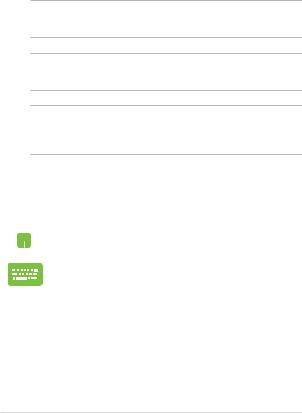
Conventions used in this manual
To highlight key information in this manual, some text are presented as follows:
IMPORTANT! This message contains vital information that must be followed to complete a task.
NOTE: This message contains additional information and tips that can help complete tasks.
WARNING! This message contains important information that must be followed to keep you safe while performing tasks and prevent damage to your Notebook PC's data and components.
Icons
The icons below indicate the devices you can use for completing a series of tasks or procedures on your Notebook PC.
= Use the touchpad.
= Use the keyboard.
Typography
Bold = This indicates a menu or an item that must be selected.
Italic = This indicates sections that you can refer to in this manual.
8 |
Notebook PC E-Manual |

Safety precautions
Using your Notebook PC
This Notebook PC should only be used in environments with ambient temperatures between 5°C (41°F) and 35°C (95°F).
Refer to the rating label on the bottom of your Notebook PC and ensure that your power adapter complies with this rating.
Do not leave your Notebook PC on your lap or near any part of your body to prevent discomfort or injury from heat exposure.
Do not use damaged power cords, accessories, and other peripherals with your Notebook PC.
While powered on, ensure that you do not carry or cover your Notebook PC with any materials that can reduce air circulation.
Do not place your Notebook PC on uneven or unstable work surfaces.
You can send your Notebook PC through x-ray machines (used on items placed on conveyor belts), but do not expose them to magnetic detectors and wands.
Contact your airline provider to learn about related inflight services that can be used and restrictions that must be followed when using your Notebook PC in-flight.
Notebook PC E-Manual |
9 |

Caring for your Notebook PC
Disconnect the AC power and remove the battery pack (if applicable) before cleaning your Notebook PC. Use a clean cellulose sponge or chamois cloth dampened with a solution of nonabrasive detergent and a few drops of warm water. Remove any extra moisture from your Notebook PC using a dry cloth.
Do not use strong solvents such as thinners, benzene, or other chemicals on or near your Notebook PC.
Do not place objects on top of your Notebook PC.
Do not expose your Notebook PC to strong magnetic or electrical fields.
Do not use or expose your Notebook PC near liquids, rain, or moisture.
Do not expose your Notebook PC to dusty environments.
Do not use your Notebook PC near gas leaks.
10 |
Notebook PC E-Manual |

Proper disposal
Do not throw your Notebook PC in municipal waste. This product has been designed to enable proper reuse of parts and recycling. The symbol of the crossed out wheeled bin indicates that the product (electrical, electronic equipment and mercurycontaining button cell battery) should not be placed in municipal waste. Check local regulations for disposal of electronic products.
Do not throw the battery in municipal waste. The symbol of the crossed out wheeled bin indicates that the battery should not be placed in municipal waste.
Notebook PC E-Manual |
11 |

12 |
Notebook PC E-Manual |

Chapter 1:
Hardware Setup
Notebook PC E-Manual |
13 |
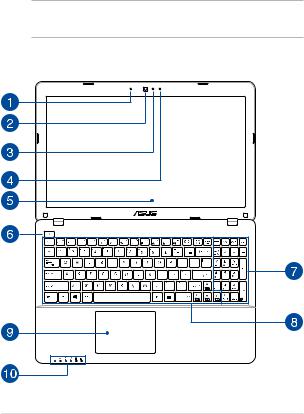
Getting to know your Notebook PC
Top View
NOTE: The keyboard's layout may vary per region or country. The top view may also vary in appearance depending on the Notebook PC model.
15” model
14 |
Notebook PC E-Manual |
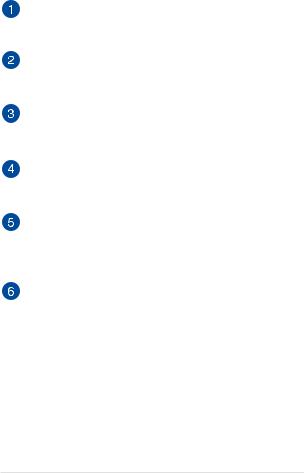
Microphone
The built-in microphone can be used for video conferencing, voice narrations, or simple audio recording.
Camera
The built-in camera allows you to take pictures or record videos using your Notebook PC.
Camera indicator
The camera indicator lights up when the built-in camera is in use.
Microphone (on selected models)
The built-in microphone can be used for video conferencing, voice narrations, or simple audio recording.
Display panel
This high-definition display panel provides excellent viewing features for photos, videos, and other multimedia files on your Notebook PC.
Power button
Press the power button to turn your Notebook PC on or off. You can also use the power button to put your Notebook PC to sleep or hibernate mode and wake it up from sleep or hibernate mode.
In the event that your Notebook PC becomes unresponsive, press and hold the power button for at least four (4) seconds until your Notebook PC shuts down.
Notebook PC E-Manual |
15 |

Numeric keypad (on selected models)
The numeric keypad toggles between these two functions: for numeric input and as pointer direction keys.
NOTE: For more details, refer to the Numeric keypad (on selected models) section in this manual.
Keyboard
The keyboard provides full-sized QWERTY keys with a comfortable travel depth for typing. It also enables you to use the function keys, allows quick access to Windows®, and controls other multimedia functions.
NOTE: The keyboard layout differs by model or territory.
Touchpad
The touchpad allows the use of multi-gestures to navigate onscreen, providing an intuitive user experience. It also simulates the functions of a regular mouse.
NOTE: For more details, refer to the Using the touchpad section in this manual.
16 |
Notebook PC E-Manual |
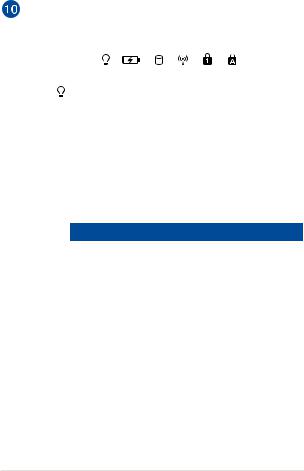
Status indicators
The status indicators help identify the current hardware status of your Notebook PC.
Power indicator
The power indicator lights up when the Notebook PC is turned on and blinks slowly when the Notebook PC is in sleep mode.
 Two-color battery charge indicator
Two-color battery charge indicator
The two-color LED provides a visual indication of the battery’s charge status. Refer to the following table for details:
Color |
Status |
Solid Green |
The Notebook PC is plugged to |
|
a power source and the battery |
|
power is between 95% and |
|
100%. |
Solid Orange |
The Notebook PC is plugged |
|
to a power source, charging its |
|
battery, and the battery power |
|
is less than 95%. |
Blinking Orange |
The Notebook PC is running on |
|
battery mode and the battery |
|
power is less than 10%. |
Lights off |
The Notebook PC is running on |
|
battery mode and the battery |
|
power is between 10% to 100%. |
Notebook PC E-Manual |
17 |

Drive activity indicator
This indicator lights up when your Notebook PC is accessing the internal storage drives.
Bluetooth / Wireless indicator
This indicator lights up when your Notebook PC’s wireless function (Bluetooth or Wi-Fi) is enabled.
Number lock indicator (on selected models)
This indicator lights up when the number lock function is activated. This allows you to use some of the keys on your keyboard for numeric input.
Capital lock indicator
This indicator lights up when the capital lock function is activated. Using capital lock allows you to type capitalized letters (such as A, B, C) using your Notebook PC’s keyboard.
18 |
Notebook PC E-Manual |
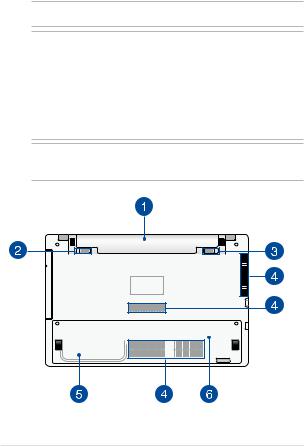
Bottom
NOTE: The bottom side may vary in appearance depending on model.
WARNING!
•The bottom of the Notebook PC can get warm to hot while in use or while charging the battery pack. When working on your Notebook PC, do not place it on surfaces that can block the vents.
•Only ASUS-authorized technicians should remove the battery inside the device.
IMPORTANT! Battery time varies by usage and by the specifications for this Notebook PC. The battery pack cannot be disassembled.
Notebook PC E-Manual |
19 |

Battery pack
The battery pack is automatically charged when your Notebook PC is connected to a power source. When charged, the battery pack supplies power to your Notebook PC.
Spring battery lock (on selected models)
The spring battery lock automatically locks the battery pack in place once it is inserted into the battery slot.
IMPORTANT! This lock should be held in an unlocked position when removing the battery pack.
Manual battery lock (on selected models)
The manual battery lock is used to keep the battery pack secured. This lock should be manually moved to a locked or unlocked position to insert or remove the battery pack.
Air vents
The air vents allow cool air to enter and warm air to exit the Notebook PC.
WARNING! Ensure that paper, books, clothing, cables, or other objects do not block any of the air vents or else overheating may occur.
Hard disk drive compartment (on selected models)
This compartment is a reserved space for the HDD (hard disk drive) of your Notebook PC.
Random-access memory module compartment (on selected models)
This compartment allows you to add RAM (random-access memory) modules to increase the memory capacity of your Notebook PC.
20 |
Notebook PC E-Manual |
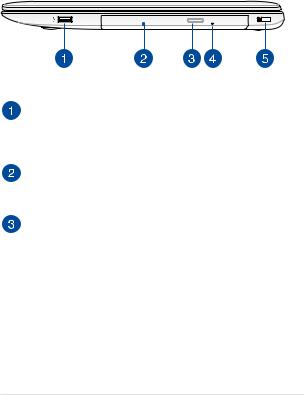
Right Side
15” and 14" model
USB 2.0 port (on selected models)
The USB (Universal Serial Bus) port is compatible with USB 2.0 or USB 1.1 devices such as keyboards, pointing devices, flash disk drives, external HDDs, speakers, cameras and printers.
Optical drive
Your Notebook PC’s optical drive may support several disc formats such as CDs, DVDs, recordable discs, or rewritable discs.
Optical disc drive eject button
Press this button to eject the optical drive tray.
Notebook PC E-Manual |
21 |

Optical disc drive manual eject hole
The manual eject hole is used to eject the drive tray in case the electronic eject button does not work.
WARNING! Use the manual eject hole only when the electronic eject button does not work.
NOTE: For more details, refer to the Using the optical drive section in this manual.
Kensington® security slot
The Kensington® security slot allows you to secure your Notebook PC using Kensington® compatible Notebook PC security products.
22 |
Notebook PC E-Manual |
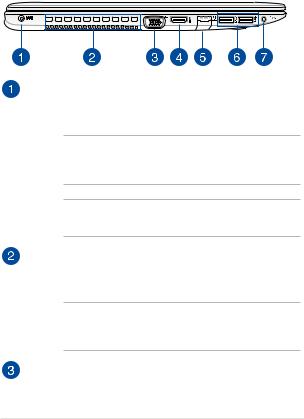
Left Side
15” and 14" model
Power (DC) input port
Insert the bundled power adapter into this port to charge the battery pack and supply power to your Notebook PC.
WARNING! The adapter may become warm to hot while in use. Do not cover the adapter and keep it away from your body while it is connected to a power source.
IMPORTANT! Use only the bundled power adapter to charge the battery pack and supply power to your Notebook PC.
Air vents
The air vents allow cool air to enter and warm air to exit the Notebook PC.
WARNING! Ensure that paper, books, clothing, cables, or other objects do not block any of the air vents or else overheating may occur.
VGA port
This port allows you to connect your Notebook PC to an external display.
Notebook PC E-Manual |
23 |
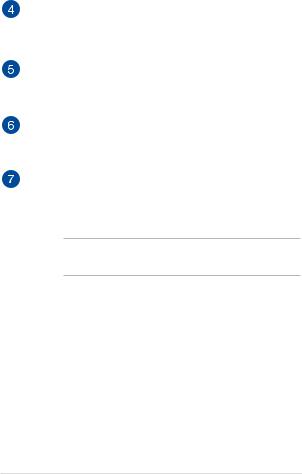
HDMI port
This port is for the HDMI (High-Definition Multimedia Interface) connector and is HDCP compliant for HD DVD, Blu-ray, and other protected content playback.
LAN port
Insert the network cable into this port to connect to a local area network.
USB 3.0 port
The USB 3.0 (Universal Serial Bus 3.0) port provides a transfer rate up to 5 Gbit/s and is backward compatible to USB 2.0.
Headphone outputjack/microphone input combo port
This port allows you to connect your tablet to amplified speakers or headphones. You can also use this port to connect your tablet to an external microphone.
NOTE: This port does not support three-conductor 3.5mm microphone.
24 |
Notebook PC E-Manual |
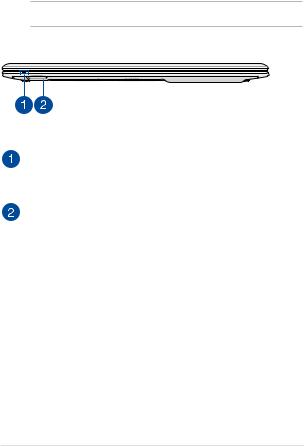
Front Side
NOTE: The front side may vary in appearance depending on model.
Status indicators
The status indicators help identify the current hardware status of your Notebook PC.
Memory card reader
This built-in memory card reader supports SD and SDHC card formats.
Notebook PC E-Manual |
25 |

26 |
Notebook PC E-Manual |

Chapter 2:
Using your Notebook PC
Notebook PC E-Manual |
27 |
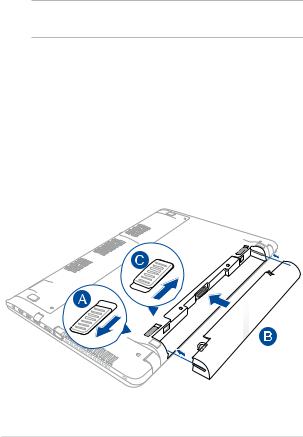
Getting started
NOTE: If your Notebook PC does not have its battery pack installed, use the following procedures for installation.
Install the battery pack (on selected models)
A.Move the manual battery lock to the unlocked position.
B.Align and insert the battery pack into the Notebook PC’s battery slot.
C.Move the manual battery lock back to the locked position after inserting the battery pack.
28 |
Notebook PC E-Manual |
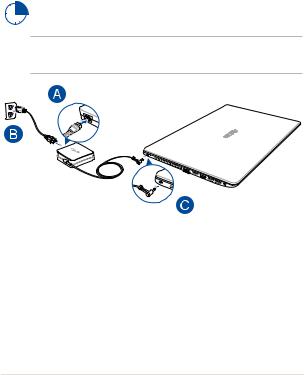
Charge your Notebook PC
A.Connect the AC power cord to the AC/DC adapter.
B.Plug the AC power adapter into a 100V~240V power source.
C.Connect the DC power connector into your Notebook PC’s power (DC) input.
Charge the Notebook PC for 3 hours before using it in battery mode for the first time.
NOTE: The power adapter may vary in appearance, depending on models and your region.
Notebook PC E-Manual |
29 |

IMPORTANT!
•Locate the input/output rating label on your Notebook
PC and ensure that it matches the input/output rating information on your power adapter. Some Notebook PC models may have multiple rating output currents based on the available SKU.
•Ensure that your Notebook PC is connected to the power adapter before turning it on for the first time. We strongly recommend that you use a grounded wall socket while using your Notebook PC on power adapter mode.
•The socket outlet must be easily accessible and near your
Notebook PC.
•To disconnect your Notebook PC from its main power supply, unplug your Notebook PC from the power socket.
WARNING!
Read the following precautions for your Notebook PC’s battery.
•The battery used in this device may present a risk of fire or chemical burn if removed or disassembled.
•Follow the warning labels for your personal safety.
•Risk of explosion if battery is replaced by an incorrect type.
•Do not dispose of in fire.
•Never attempt to short-circuit your Notebook PC’s battery.
•Never attempt to disassemble and reassemble the battery.
•Discontinue usage if leakage is found.
•The battery and its components must be recycled or disposed of properly.
•Keep the battery and other small components away from children.
30 |
Notebook PC E-Manual |
